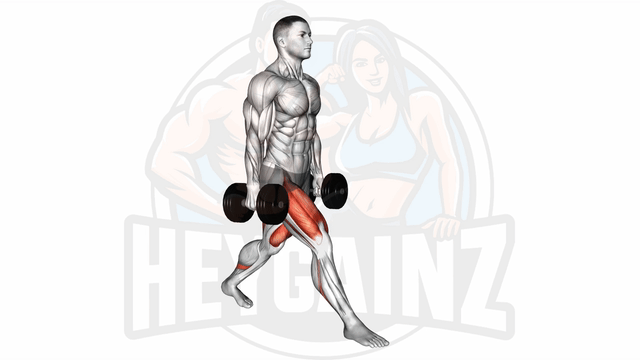
Instructions:
- 1Stand with your feet hip-width apart, and hold a dumbbell in each hand by your sides
- 2Step one foot forward, and lower your body until your front knee is at a 90-degree angle
- 3Drive through your front heel to push back up to the starting position
- 4Repeat for desired reps, then switch to the other leg
Tips:
- Keep your upper body upright throughout the exercise
- Make sure not to let your front knee extend beyond your toes
- Engage your core for balance
- Keep your movements slow and controlled to target the muscles effectively
Dumbbell Split Squat: A Comprehensive Guide
The dumbbell split squat is a highly effective lower body exercise that primarily targets the gluteus maximus and quadriceps, making it a staple in many strength training and conditioning programs. This unilateral movement helps to improve muscle imbalances and enhance overall lower body strength.
Muscles Worked
When performed correctly, the dumbbell split squat engages several key muscles:
- Gluteus Maximus: The primary muscle worked, responsible for hip extension.
- Quadriceps: These muscles are engaged as you lower your body and push back up.
- Hamstrings and Calves: These muscles assist in stabilizing and performing the movement effectively.
Proper Form
To perform the dumbbell split squat with optimal form, follow these steps:
- Stand with one foot forward and the other foot back, creating a split stance.
- Hold a dumbbell in each hand at your sides, maintaining a straight posture.
- Lower your body by bending the front knee, ensuring it does not extend beyond your toes.
- Push through your front heel to return to the starting position.
Paying attention to form is crucial to avoid injuries and maximize benefits, so consider using a dumbbell split squat gif as a visual aid to help you better understand the movement.
Variations and Alternatives
If you're looking for alternatives to the dumbbell split squat, consider the dumbbell lunge, which provides similar benefits but with a different movement pattern. The dumbbell split squat bench can also be utilized for added stability.
Comparisons
When comparing the dumbbell split squat vs lunge, both exercises are effective for targeting the lower body. However, the split squat offers more stability and can be beneficial for isolating muscles. Additionally, when assessing the dumbbell split squat vs barbell, dumbbells often allow for a greater range of motion and easier balance control, making them a preferable choice for many individuals, especially beginners.
Choosing the Right Weight
The dumbbell split squat weight should be tailored to your individual fitness level. Start with lighter weights to master proper form and gradually increase the load as your strength and confidence improve.
Incorporate the dumbbell split squat into your routine to build strength and enhance muscle tone in your hips and thighs. Consistent practice will help you master this fundamental exercise.